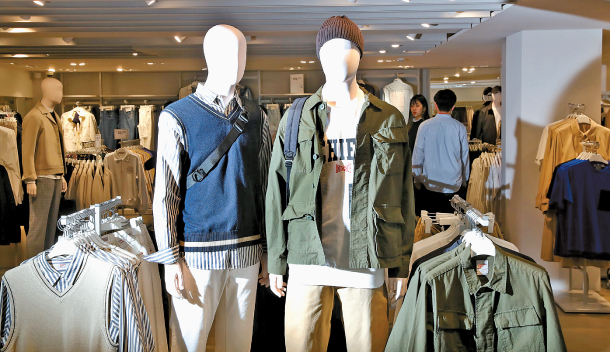Computer buyers buy better, could do more

Clothes displayed at an 8seconds store in southern Seoul, on Thursday. The products are chosen using suggestions from AiFITs, an artificial intelligence program developed by Samsung C&T. [WOO SANG-JO]
The computers are not coming up with designs and picking trends - yet. They are being used for making stock and inventory decisions, determining how many of a given product is needed from one season to the next depending on a number of variables.
In real world tests, the artificial intelligence (AI) buyer gets it right every time. An experienced merchandiser is normally right about 60 percent of the time when picking and choosing products to roll and when to make them available.
The name of the program, which was developed by Samsung C&T in 2015, is AiFITs. It has been utilized since last fall. Adjusting inventory has long been a headache in the fashion industry. Companies invest huge sums into deciding how much of a certain product will be sold by accumulating data about trends, the business cycle, public sentiment and weather. They commit so much to getting this right because the brand depends upon it.
An outdoor-wear brand prepared the right number of long-padded coats after anticipating the 2017 bench coat craze, and profited handsomely as a result. On the other hand, companies that thought this trend would last through 2018 are now stuck with warehouses of long-padded coats. The weather was warm and the fad came to a sudden end.
Managing stock is sometimes more important than sales.
For a long time, deciding the quantity of products was determined by merchandiser intuition and luck.
“We made the AI to emulate how a good merchandiser works, but it produced better results than an ordinary merchandiser since it accumulated data over a few years,” said Kim Jun-gle, leader of the AiFITs strategy team.
What is more surprising about AiFITs is the speed at which it makes decisions.
Although a merchandiser is experienced, it takes them at least a week to determine the final quantity of a product to be sold since they have to consider a number of variables.
Samsung C&T’s AI can do it in just a few seconds.
“AiFITs is still in the process of being verified, so I choose [the products] by myself and then refer to its results,” said Yoon Dong-hee, a merchandiser with 18 years of experience at 8seconds, a casual brand focused mainly on women’s clothing. “However, when comparing the results afterward, AiFITs is more accurate, so honestly I rely on AI more these days.”
It also inspires humans by suggesting draft designs after predicting the clothes and colors that will be trending based on comments on social media.
The industry has been slow to adopt the technology. Fashion is considered a business related to emotions, so people mostly thought it would be difficult for computers to handle trends and styles.
But large IT companies are starting to lead the way. Amazon has been using a fashion algorithm since 2017, and sector analysts say that the algorithm is already relevant in their work.
“It’s hard to say that our AI is better than that of big IT companies, but we set ourselves apart from them with the unique data that we, as a fashion company, have,” said Kim.
“Our goal is to complete an AI system where all of the process from designing and selling a product to curating shopping experiences for consumers is based on data,” said Hwang Seoung-man, chief information officer at Samsung C&T.
BY CHUN YOUNG-SUN [kim.heyu@joongang.co.kr]










with the Korea JoongAng Daily
To write comments, please log in to one of the accounts.
Standards Board Policy (0/250자)